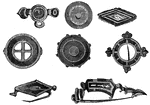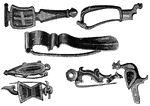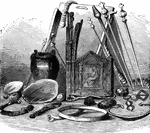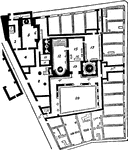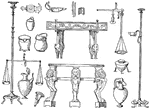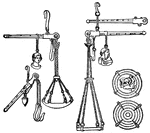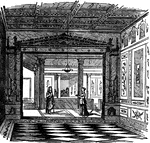Clipart tagged: ‘pompeii’

Alexander
Alexander defeating the Persians. This is an illustration of the Alexander Mosaic, found on the floor…
Roman Amphora
This Roman Amphora is made out of iridescent glass and was found in Pompeii, Ancient Rome.
Aulos
"Roman Ivory Aulos found at Pompeii, showing slides and rings." — The Encyclopedia Britannica,…

Antique Roman balance from Pompeii
This antique Roman balance from Pompeii has one pan that hangs from a rod.

Banqueting room
"The Roman people reclined at their meals. On each couch there were commonly three persons. They lay…

Roman Bedstead
This Roman bedstead had a Pompeian vase-painting. It included a head and foot board. It was made out…

Antique Serpent Bracelet
This Serpent antique bracelet is in the form of a viper. It came from Pompeii, Rome.

Ionic Capital
The ionic capital is a design of a scroll rolled on both sides with spiral curves. It was found in Pompeii.
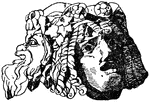
Mask Decoration
The mask decoration was founded in Pompeii, Rome. These masks were used as keystone decorations of doors…

SideMask Decoration
The mask decoration was found in Pompeii, Rome. These masks were used as keystone decorations of doors…
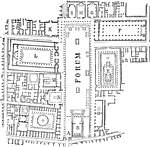
Forum of Pompeii
"Forum of Pompeii. A, principal entrance; B, a Corinthian temple; C, the public prison (carcer publicus);…
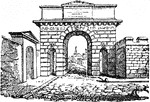
Gate at Herculaneum
The gate at Herculaneum. Herculaneum was an ancient Roman town famous for being preserved along with…

Pompeiian House
"House construction consists mainly of concrete or brick, and sometimes of stone blocks, especially…
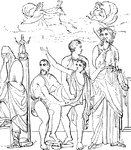
Sacrifice of Iphigenia
"The cut represents a painting from a wall at Pompeii, the subject of which is the sacrifice of Iphigenia,…

Mount Vesuvius
The parts of a volcano illustrated with Mount Vesuvius: "a, the cone; b, summit cinder-cone; c, Somma,…
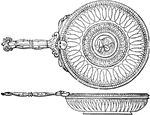
Patera
"The patera was a broad and comparatively shallow bowl used for libations, and also for drinking out…
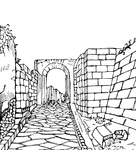
Pompeii
"The following cut gives a view of of a portion of the paved street at the entrance of Pompeii. The…

Pompeii Graffiti from the House of Dioscuri - Gladiator Holding Palm Leaf
A drawing of one section of the graffiti found on the house of Dioscuri in Pompeii. A gladiator descends…

Cast of a Body Found at Pompeii
"The bodies of those who perished were buried under layers of fine pumice stones and ashes. When plaster…
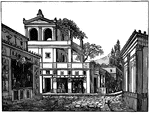
Streets of Pompeii
An illustration of the streets of Pompeii. Pompeii is a ruined and partially buried Roman town-city…

Surgical Instruments from Pompeii
Illustrations of various surgical instruments used in Pompeii, Italy.
Pompeiian Stand with Lighted Oil Lamp
A tall, thin lamp stand on a round, ornamented base with three claw feet. The top of the stand has a…
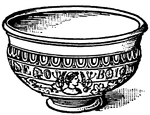
Roman Bowl - Gaulish Samian Ware or Terra Sigillata
Illustration of a Roman bowl found in Pompeii and made by the Gauls. It is an example of what is referred…

Roman Cameo-Glass
"Ancient Roman Cameo-Glass. Amphora from Pompeii, Museo Nazionale, Naples." -Whitney, 1911
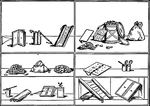
Roman School Materials - Based on a Wall Painting from Pompeii
An illustration of a Pompeiian wall painting of school materials, including scrolls, books, writing…
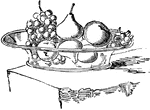
Still Life Painting from Pompeii
"Painting of still life. On a wall of a house at Pompeii." —D'Anvers, 1895
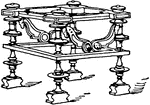
Roman Bisellium Stool
The Roman Bisellium Stool also called the Roman double stool, was made of bronze but did not have a…
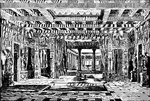
The Interior (Atrium and Peristylium) of Pansa's house at Pompeii, Restored
Illustration of a restored atrium and peristylium of the House of Pansa at Pompeii. The impluvium, pool,…

Support of Roman Table Trapezophoron
The support of Roman table Trapezophoron is a shown in the front view and side view. It is found in…
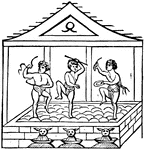
Winemaking
"Copied from the wall of a house in Pompeii, representing the vintagers treading grapes with their feet."…


